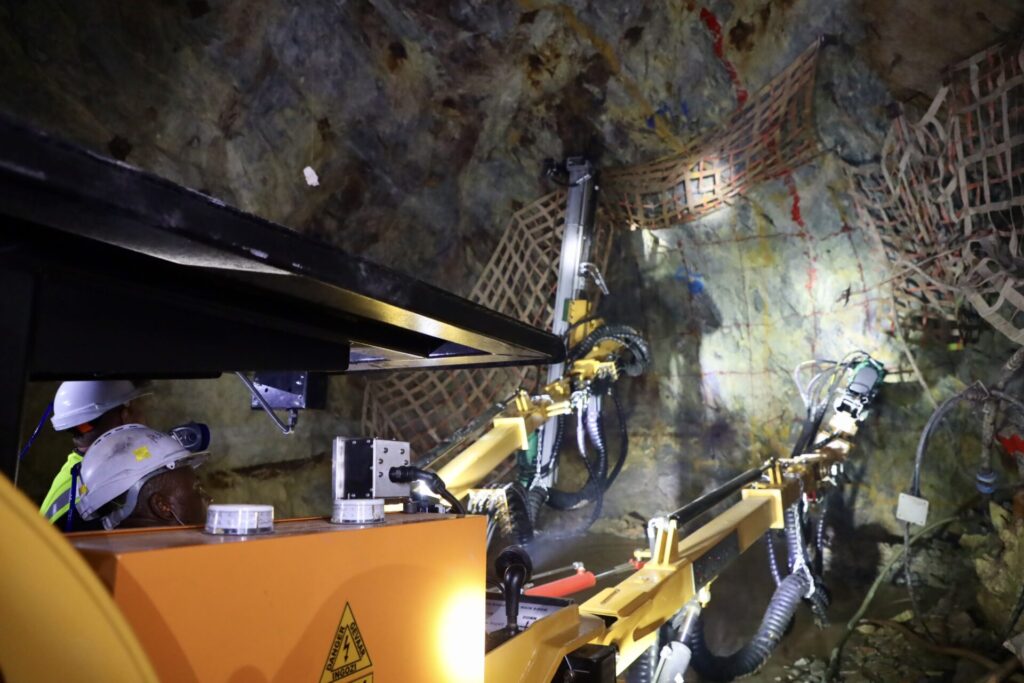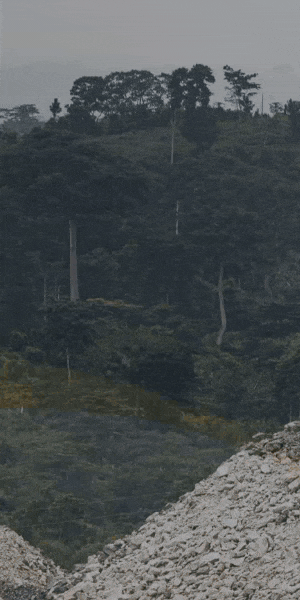First Ore Extracted as West Wits Mining Transitions from Developer to Producer

West Wits Mining produces first ore Oct 2025, tracking the above model in Witwatersrand Basin. Fully funded to 70k oz/year, targeting 200k oz within 3 years. Strong gold price.
- West Wits Mining commenced underground ore production on October 14, 2025, marking transition from development to operational phase with first physical blast and ore transport
- Production currently tracking marginally above resource model expectations, with drilling and blasting cycle times completing within single shifts and multi-blast preparation advancing
- Company implementing modern hydropower technology over traditional compressed air systems, delivering significant power savings and improved equipment availability
- Project remains fully funded to steady-state production of 70,000 ounces annually, with eight-nine month payback period and sufficient capital for first lender drawdowns
- Long-term growth target of 200,000 ounces per annum within three years requires additional prospecting rights, prefeasibility work, and potential own processing plant
West Wits Mining (ASX:WWI) has reached a critical inflection point in its development trajectory, transitioning from project developer to gold producer in South Africa's renowned Witwatersrand Basin. In this detailed operational update, Managing Director and CEO Rudi Deysel provides investors with comprehensive insights into the company's execution progress following the mobilization of mining contractors in July 2025. With gold prices providing favourable tailwinds and the company's underground operations now producing ore, the focus has shifted from financing and feasibility to operational excellence and sustainable production ramp-up.
First Ore Production Milestone Achieved
West Wits Mining achieved a significant milestone on October 14, 2025, producing its first ore from underground operations. This followed a three-month mobilization period beginning in July, during which both mining contractors and EPCM (Engineering, Procurement, Construction Management) contractors were deployed on site.
The project's unique structure allows for simultaneous development and production, facilitated by the company's previous early works that established an operational footprint. Stockpiles already on site have been transported to Sibanye Stillwater's Ezulwini processing plant, where West Wits has secured tolling arrangements. This dual-track approach of advancing development while generating revenue represents a strategic advantage during the critical ramp-up phase.
Underground Development Progress
The underground development program centers on three primary access points: the one-west decline, one-east decline, and the main decline. The one-east and one-west declines serve as temporary, flexible access routes to early ore, while the main decline will ultimately function as the primary shaft with a 17-year life-of-mine design requirement.
Ground conditions have exceeded expectations, with the operation encountering fresh rock and excellent stability. The company is progressing with systematic support processes integrated into production cycles. While the main decline advance rate is slower near surface due to oxidised levels requiring extensive civil works to ensure permanent infrastructure, the other two declines are advancing rapidly. Drilling and blasting cycle times are completed within single shifts, meeting initial expectations, with continuous improvement positioning the operation for multi-blast preparations during single shifts.
Establishing Sustainable Mining Practices
At this early production stage, management has prioritised establishing sustainable mining practices and quality standards over pure volume metrics.
"The main focus now is to get the guys to really focus on the quality of mining. We've got to set standards and set expectations from our side. That's really the only way you could actually create that sustainable mining environment."
This disciplined approach involves strict adherence to mining cycles and procedures, with extensive coaching provided to face workers. The company recognises that establishing proper rhythms and cycles at this stage, when the working environment remains relatively small with limited active faces, creates the foundation for achieving production targets as operations scale. The emphasis on culture, particularly safety culture, and cycle efficiency reflects management's experience-driven understanding that operational discipline established early becomes embedded in organizational DNA.
Interview with Rudi Deysel, Board MD & CEO OF West Wits Mining
Modern Technology Implementation
Surface infrastructure development has progressed in parallel with underground operations, focusing on ensuring service capacity can support the planned production profile. Power infrastructure, service water, potable water, and supporting facilities are being scaled appropriately to match underground advancement. This phased infrastructure approach prevents over-investment while ensuring production isn't constrained by support systems. West Wits Mining has embraced modern technology from inception, leveraging the advantage of greenfield development.
"We've got a clean sheet of paper with this in mind. So we've got that opportunity where we can really work with new technology from the beginning."
The company has implemented volume scanning rather than conventional surveying, electronic sampling systems on load buckets with manual verification, and vibration monitoring for every blast. This digital infrastructure provides real-time data for decision-making while meeting environmental monitoring requirements for operations near populated areas.
Perhaps most significantly, the company has adopted hydropower technology over traditional compressed air and pneumatic drills common in older South African mines. This delivers substantial power efficiency gains by eliminating compression losses and leakage issues.
"There's a huge power savings on hydropower and purely due to the fact that you don't have that efficiency losses right, which you actually have with leakages and that type of thing."
The decentralised power pack system positioned at working faces also improves availability, preventing mine-wide shutdowns that centralised systems can experience.
Equipment Fleet Expansion
Current underground equipment includes a seven-tonne LHD (Load-Haul-Dump unit) and one double-boom drill rig, adequate for present mining volumes. However, significant capacity expansion is imminent, with the first truck and utility vehicles scheduled for delivery in the following week.
"Next week we will actually receive our first truck and then as well as our UV utility vehicles, which you use for construction. Now that will actually accelerate the whole process and then suddenly you'll see a big jump in terms of trimming of material out of the mine."
The operation has commenced multi-shift operations, including night shifts, positively impacting tonnage production. As the company approaches multi-blasting approval, it anticipates doubling production capacity at affected working faces. This phased equipment deployment aligns capital expenditure with production requirements while maintaining flexibility.
Grade Control Performance
Resource confidence remains high, supported by extensive historical data from the Witwatersrand Basin's long mining history. Early sampling results show the operation tracking marginally above modelled expectations. "At this point we are actually marginally above what we expected," Deysel reported, noting that geologists tend toward conservatism given the wealth of surrounding data from neighbouring operations like Harmony's Doornkop mine.
The extended funding process, while challenging at the time, provided unexpected technical benefits. Due diligence requirements resulted in extensive sampling and quality control work, allowing the technical team to develop comprehensive procedures before production commenced. This advanced preparation has positioned the company ahead of typical development curves for metal accounting, grade control, and quality tracking from mine to processing plant. Current stockpile management targets 30,000 tonnes to achieve consistent gold split and optimal recoveries, accounting for initial dilution from larger development excavations before transitioning to cleaner stopping ore.
Processing Arrangements and Recovery Performance
The tolling arrangement with Sibanye Stillwater's Ezulwini plant provides processing capacity without requiring upfront capital for dedicated facilities. Processing commencement awaits reaching the 30,000-tonne stockpile target to ensure consistent feed grade and optimal recovery rates. Previous open-cast mining of the same Kimberley Reef formations yielded excellent recoveries, and bottle roll tests on current material indicate results exceeding feasibility study assumptions.
Ore preparation protocols ensure material meets mill specifications, requiring relatively dry run-of-mine material with minimal moisture content. Careful stockpile management prevents carbonaceous material contamination that could cause froth-robbing and gold losses. While currently focused on the Sibanye arrangement, the company maintains relationships with other regional processors including Harmony and Pan African Resources, providing optionality and competitive tension on processing terms.
Financial Position with Capital Discipline
The project is fully funded through to consistent production, with sufficient capital to reach first drawdowns from lenders including the Nebari facility. The financing structure provides an eight-to-nine-month payback period at current gold prices, significantly enhanced by gold's performance above the DFS base case assumptions.
"We are fully funded to get to our consistent production. We also have enough money to get us to that point where we can have our first draw downs from our lenders."
Management maintains strict focus on cost control and all-in-sustaining-cost metrics, recognising that disciplined capital allocation during small-scale operations establishes organizational culture.
"Our biggest target is that all in sustaining cost units that we want to... when you start running into trouble you throw bodies at that problem and that's got a huge impact on your unit cost."
The company has incorporated a 15% cost overrun contingency, though management's emphasis on efficiency and avoiding unnecessary labor expansion suggests confidence in remaining within budget.
Growth Pathway to 200,000 Ounces
West Wits Mining's aspirational production target of 200,000 ounces annually represents nearly triple the current project's 70,000-ounce steady-state capacity. Achieving this requires securing additional prospecting rights to expand the resource base, completing prefeasibility and definitive feasibility studies for expanded operations, and likely constructing a dedicated processing plant.
"We reckon in the next 3 years we could actually get to that point where we start with that type of development."
This growth program is already underway, with work commenced on firming up resources and optimising infrastructure placement for directional growth. The company maintains regular dialogue with potential financial partners interested in funding expansion, reflecting market appetite for larger projects at current gold prices. "I think the other thing is once you prove yourself as a good operator and you deliver what you promised then you really get financial partners that support you,"emphasising that near-term execution success will facilitate future capital access.
The company follows annual technical and economic update cycles, with quarterly cost reviews and ongoing resource base expansion efforts. This systematic approach to modelling and planning supports both operational optimization and strategic growth initiatives, maintaining flexibility to capitalise on opportunities as the Witwatersrand Basin's extensive geological database reveals additional targets.
The Investment Thesis for West Wits Mining
- De-risked Transition to Production: Company has successfully mobilised contractors, produced first ore (October 14, 2025), and is completing drilling/blasting cycles within single shifts, demonstrating execution capability during critical ramp-up phase
- Resource Quality Exceeding Expectations: Early production tracking marginally above resource model in one of world's best-understood ore bodies (Witwatersrand Basin), with conservative geological modeling and extensive historical data providing high confidence
- Technology-Enabled Cost Advantage: Greenfield implementation of modern hydropower systems over traditional compressed air delivers significant power savings, improved equipment availability, and reduced operational costs versus legacy South African operations
- Favorable Gold Price Environment: Current gold prices substantially above DFS base case assumptions enhance project economics, accelerate debt payback (8-9 month period), and improve optionality for future expansion financing
- Fully Funded to Cash Flow: Project capitalised through to steady-state production with sufficient funding to reach lender drawdown milestones, eliminating near-term dilution risk while maintaining 15% cost overrun contingency
- Clear Growth Pathway: 200,000-ounce annual production target (vs. 70,000-ounce current project) achievable within three years through prospecting right acquisitions, prefeasibility work underway, and strong interest from financial partners for expansion funding
- Toll Processing Flexibility: Sibanye Stillwater Ezulwini arrangement provides immediate processing capacity without upfront plant capital, while relationships with Harmony and Pan African Resources create competitive optionality and pricing tension
- Operational Discipline and Culture: Management emphasis on establishing quality mining standards, safety culture, and cost control during small-scale phase creates sustainable foundation for production scaling and profitability
- Modern Digital Infrastructure: Volume scanning, electronic sampling systems, real-time vibration monitoring, and comprehensive metal accounting from mine-to-plant provide data-driven operational optimization and grade control confidence
- Experienced Management Executing Systematically: CEO Rudi Deysel's methodical approach to establishing mining cycles, training protocols, procurement planning, and infrastructure phasing demonstrates operational expertise translating feasibility to reality
Macro Thematic Analysis:
The South African gold mining sector is experiencing renewed investment interest as elevated gold prices intersect with modern mining technologies to unlock value in historically productive but operationally challenging jurisdictions. West Wits Mining's development exemplifies this thematic shift, applying contemporary techniques like hydropower systems and digital monitoring to the Witwatersrand Basin's extensively characterised geology. The competitive labor market Dil describes with both gold and PGM operations competing for skilled workers signals broad-based sectoral activity rather than isolated opportunity. Modern equipment, systematic support systems, and greenfield operational design overcome legacy infrastructure constraints that burden established producers. South Africa's mining code stability, combined with jurisdictional familiarity among international financiers, positions well-managed new operations to access growth capital as demonstrated by West Wits's funding success and ongoing expansion discussions. The macro opportunity crystallises in Deysel's observation:
"People would rather fund a bigger project than these smaller projects... we are actually quite confident and then obviously you've got this revenue stream that you could also put in from your side."
TL;DR:
West Wits Mining has successfully transitioned from developer to producer, achieving first ore on October 14, 2025, with early production tracking above resource model expectations in South Africa's proven Witwatersrand Basin. The fully-funded project employs modern hydropower and digital technologies to achieve cost advantages while management's disciplined focus on operational quality and cycle efficiency during ramp-up establishes foundations for sustainable cash generation. With gold prices substantially above feasibility assumptions, an eight-nine-month payback period, and clear pathway to 200,000-ounce annual production within three years, the company is executing a de-risked growth strategy in a favorable macro environment.
FAQ's (AI Generated)
Analyst's Notes




Subscribe to Our Channel
Stay Informed



































